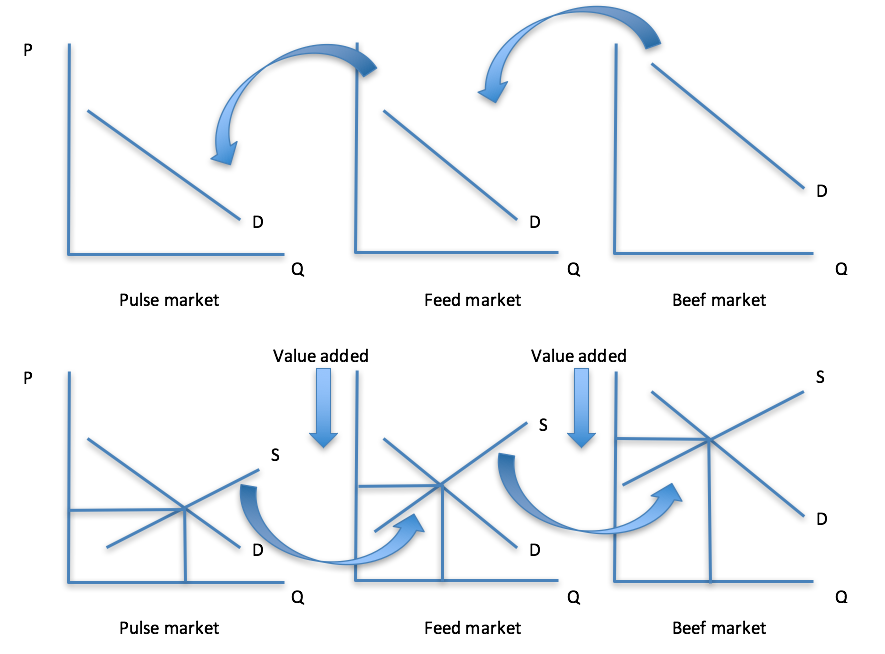Now that you know all about demand and supply, we should look at the relationship between the two. In general, demand gives rise to supply. As long as there is a demand for goods and services, there will be supply (illegal or otherwise). The war on drugs has been going on for decades, yet the demand remains meaning there will always be producers willing to supply (very high incentives in this case.) Black markets are another example of demand giving rise to supply – anything you want, you will likely be able to get. So let’s look at derived demand in legal agricultural products. The article below talks about the increasing demand for protein from plants.

Figure 7.8 An example of derived demand on the Prairies. Source: https://prairiemanufacturer.ca/2018/09/09/paving-the-protein-highway/ Permission: This material has been reproduced in accordance with the University of Saskatchewan interpretation of Sec.30.04 of the Copyright Act.
The population is growing and there will be increased demand for protein for a variety of reasons that will ultimately affect the supply chain. Before we talk about a change in demand, let’s just look at demand.

Figure 7-9: Derived demand giving rise to supply. Permission: Courtesy of course author Hayley Hesseln, Department of Agriculture and Resource Economics, University of Saskatchewan.
First, there is a demand for beef, which we might call a final or tertiary good. The demand for meat then gives rise to the demand for animal feed (a secondary good). And, the demand for animal feed gives rise to the demand for pulses or plant protein (a primary good). Figure 7-9 indicates derived demand moving from right to left.
If there is a demand for a product there will be a supply because there is money to be made. So, following the lower panel of graphs, there arises a supply of pulses that is turned into the supply of feed (bottom middle panel), which then is turned into beef in the beef market – the transition from one market to the next is known as the supply chain.
We could follow demand and supply for many agricultural products from the raw materials (crops) to their intermediate products (ingredients into other production processes), and then into final goods. In forestry, it might be trees, turned into logs, turned into lumber, turned into partially finished building products, and eventually turned into houses or furniture for example.
Identify a supply chain for an agricultural product from raw material to finished product.
What happens in between the markets? Each market represents a different product with different measures of quantity and prices. Have you heard the term “value-added”? Between markets, we are actually adding value. That means we are making products more valuable. Certainly, pulses are valuable, but until we process them and use other ingredients, they are not considered animal feed. And animal feed is valuable, but once cattle consume it, it becomes more valuable as beef. You probably recognize that a certain amount of pulses (a bushel let’s say) has value. That same amount (a bushel) accounted for in feed would be more valuable – it would have a higher price. And, if we could measure a bushel of pulses in beef, we would see an even higher value. Finished products are more valuable because they are more useful and because the costs of finishing them must be accounted for.
In between each of these markets, we must pay drivers, transportation companies, fuel costs, millers, insurance companies, marketing agents, etc.: any individual or business that is responsible for moving goods between markets and for transforming raw materials or partially finished goods into those more finished or final goods. Each of these entities earns income that supports communities and the economy. The more we can process in Saskatchewan, or any small jurisdiction, the better for that community.
Economic modelling tells us that it’s more efficient, most of the time, to add value closer to the population that will consume the products. That means we ship most of Saskatchewan’s wheat to eastern Canada to be turned into bread. If we made all the bread where the wheat was grown, it would cost more to ship, and given the cost of transportation and the likelihood of spoilage, it makes more economic sense to ship raw materials.
Here’s what the government of Saskatchewan has to say about value-added. Be sure to visit this link:

Figure 7-10: The importance of value-added. Source: https://www.saskatchewan.ca/business/agriculture-natural-resources-and-industry/agribusiness-farmers-and-ranchers/adding-value-to-agricultural-products/ministry-of-agriculture-value-added-strategy Permission: This material has been reproduced in accordance with the University of Saskatchewan interpretation of Sec.30.04 of the Copyright Act.
Most of Saskatchewan’s raw materials are shipped to markets where they will be processed and turned into final goods. We ship uranium, other metals, a variety of agricultural products, and timber products east, west and south (not much goes north).
What we can do next is introduce a shock in the beef market. What were the effects of a decrease in demand for Canadian beef by the US as a result President Donald Trump’s rejection of NAFTA[1] resulting in closed borders to Canadian beef?
We could also explore a different type of shock. Assume there is a blight that wipes out pulse crops. How would that shock play out in the markets?
To answer these questions, we need another piece of information regarding the degree to which price changes will affect the quantity supplied and demanded. We turn now to elasticity.
[1] NAFTA is the North American Free Trade Agreement
